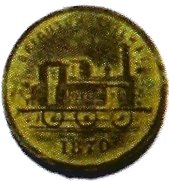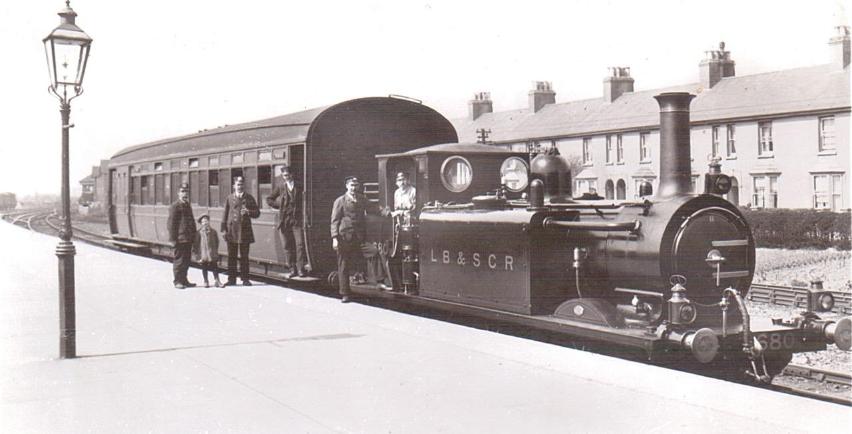
The Lewes Loco shed was closed in 1870, by the L.B.S.C.R. due to the enlargement of the station.
The Chichester Loco shed was closed in c1870s, by the L.B.S.C.R. as a result of re-modelling of the Chichester area 1875.
THE WORKING OF THE SMALLER
L.B.S.C.R. LOCO SHEDS.
Among the smaller sheds, Three Bridges was unique in that its central position on the system, which meant that over its life its engines worked regularly to most parts of the London Brighton & South Coast Railway. The only lines over which there does not to appear to recorded that Three Bridges engines working are Polegate to Hastings, Chichester to Midhurst, West Croydon to Epsom Downs, Wimbledon & Hayling branch line
The actual date when the first shed at Thee Bridges was opened on the upside adjacent to the station is obscure. It was certainly was not built when the line was opened in 1841. The Horsham branch (1848) was worked from Horsham shed, and the East Grinstead branch (1855) from East Grinstead shed, until it absorbed into the L.B.S.C.R. in 1865. Following the opening of the Horsham to Petworth line in 1859 an amendment to the working timetable dated December 1859 shows a 5.45 a.m. goods Three Bridges to Petworth and 9.0 a.m. return “worked from Three Bridges” so it would seem there was a shed there then.
Opening of the Hardham Junction to Ford section in August 1863, increased the importance of Three Bridges as there was now a service of local trains between Three Bridges and Ford, plus expresses to and from Portsmouth formed of carriages to/or detached from main line express trains at Three Bridges. Three Bridges shed shared the local trains to Ford but the Portsmouth express were worked exclusively by Portsmouth engines some of which spent several hours at Three Bridges. The Petworth goods ceased at the same time being replaced by a goods from Littlehampton to Three Bridges and back.
In 1870 Three Bridges had three turns. One made two local passenger trips to Ford and back, the second four trips to East Grinstead and back, starting and finishing with goods trips, while the third was a 3.15 p.m. slow to Portsmouth, and back along the coast to Brighton, finishing with the 9.0 p.m. to Haywards Heath and light engine to Three Bridges.
By 1886 the new station at East Grinstead and the line from South Croydon to Culver Junction had been opened. Three Bridges shed had some Stroudley Class “D” and “E” tank engines, plus some 2-4-0 and 0-6-0 types from the Craven era, and five turns including one to London. The London trip was on the 8.45 a.m. East Grinstead to London Victoria via Oxted, and after some suburban working the engine worked the 4.0 p.m. London Victoria to Tunbridge Wells as far as Three Bridges where the engines were changed over. It then took the carriages off the 5.5 p.m. London Bridge to Eastbourne to East Grinstead, returning with a goods train back to Three Bridges.
The other turns were:
Locals to Littlehampton and back to Three Bridges.
1, Goods to Redhill Goods, then (Mon, Wed & Fri) to Crawley, Norwood and back to Three Bridges. (Tues, Thurs, & Sat) to East Grinstead, Crawley, Redhill Junction (SER) and back to Three Bridges
2, Goods train to Tunbridge Wells and back to Three Bridges
3, Goods train to Tunbridge Wells and shunting duties at Three Bridges.
By 1896 the Redhill goods shunting engine formerly based at Earlswood was based at Three Bridges and the “D” tank shedded at East Grinstead since 1883 was also at Three Bridges. The shed now had five passenger turns, and two goods turns for which a stud of Class “D1s” and “E1s” were allocated passenger jobs which included three turns to London, the original 8.40 a.m. ex East Grinstead, the 8.08 a.m. Lewes via Sheffield Park which was formerly worked by the East Grinstead engine, and a new working from Horsham to London via the “Back Road” (Dorking and Streatham.
The other two turns were local trains to Tunbridge Wells and to Brighton and Worthing.
The two goods turn were:
1, Goods train to Redhill Junction then to Haywards Heath, where 3 ½ hours of shunting time permitted, plus trips between Haywards Heath to Horsted Keynes, Lewes or Hassocks as required before returning back to Three Bridges.
2, Carriages off the 5.05 p.m. London Bridge to Eastbourne to East Grinstead, return back to Three Bridges with a goods train. After arriving at Three Bridges it then work the “Night Good Pilot,” shunting at Three Bridges.
By 1911 the Three Bridges shed allocation of engines had increase to nine (“D1” Nos. 249, 258, 275, 03, 390, 394. “E1” 101, 110. “E4” 465 & “E5” 587), and the workings of eight, with trips to Bognor and Tunbridge Wells. The local goods trips to Redhill and Haywards Heath had ceased and instead Three Bridges had a “Roundabout” turn to hove via Horsham, and returning back to Three Bridges via Hassocks, workings which up to that time had been the sole prerogative of the Brighton Shed.

An L.B.S.C.R. Engineman's button
L.B. & S.C.R. Footplate Rates Of Pay 1870- 1874
Drivers
Year Rate Per Day
1st Year 5/-
2nd Year 5/6
3rd Year 6/-
4th and 5th Year 6/6
6th Year 7/-
Firemen
Year Rate Per Day
1st Year 3/-
2nd & 3rd 3/6
4th Year 3/9
5th Year 4/-
Cleaners
Age Rate Per Day
16 1/4
17 1/8
18 2/-
19 2/4
Bar Boys 8?
In 1872 a Superannuation Fund was established for higher grades of staff, which was
extended to become a pension fund for all staff in 1899.

ELIZABETH WICKSTEAD COLLECTION
Railway accidents on the
L.B.S.C.R.
from http://www.railwaysarchive.co.uk